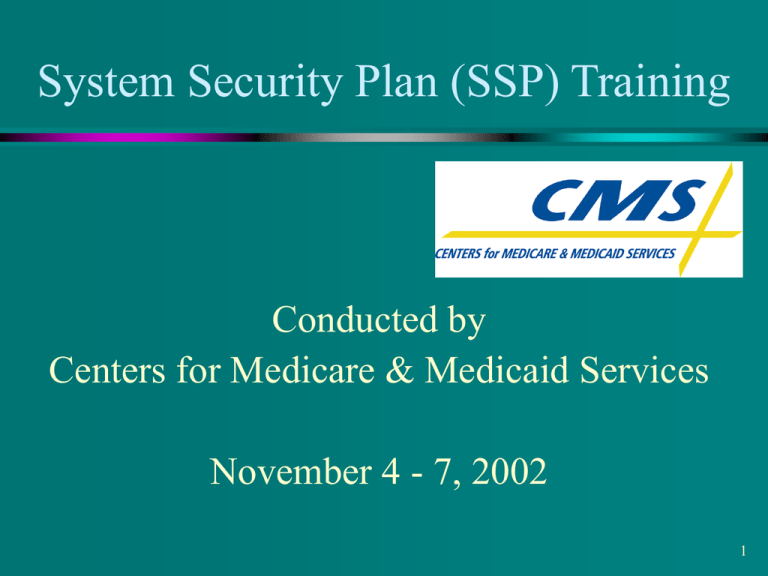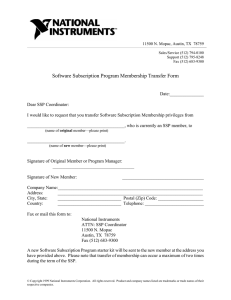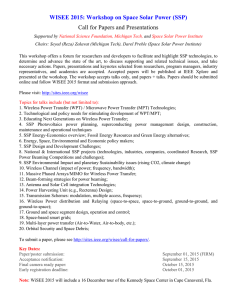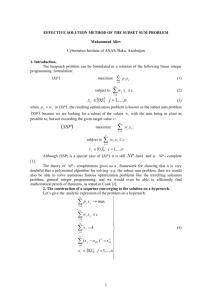System Security Plan (SSP) Training Conducted by November 4 - 7, 2002
advertisement

System Security Plan (SSP) Training Conducted by Centers for Medicare & Medicaid Services November 4 - 7, 2002 1 Faculty List instructors contact information 2 Risk Assessment (RA) Methodology Describes steps to produce IS RA Report The Information Security Risk Assessment process is presented as the following three phases: System Risk Documentation Phase Determination Phase Safeguard Determination Phase 3 System Documentation Phase 1.1 System Identification Official System Name System Acronym System of Records (SOR) Financial Management Investment Board (FMIB) Number Web Support Team (WST) Number N/A System Type (select one) GSS, MA or “Other” System N/A Name of Organization Address City, State, Zip Contract Number, Contractor contact information (if applicable) 4 System Documentation Phase 1.1 System Identification (con’t) Name of Individual Title Name of Organization Address Mailstop City, State, Zip Email Address Phone number Contractor contact information (if applicable) 5 System Documentation Phase 1.1 System Identification (con’t) Name (SSO) Title Name of Organization Address Mailstop City, State, Zip Email Address Phone number Emergency Contact Information (name, phone and e-mail only) 6 System Documentation Phase 1.1 System Identification (con’t) 1.2 Asset Identification 1.2.1 System Environment and Special Considerations 1.2.2 System Interconnection/Information Sharing 1.3 System Security Level 7 Risk Determination Phase Identify potential dangers to information and systems (threats). 2) Identify the system weakness that could be exploited (vulnerabilities) associated to generate the threat/vulnerability pair. 3) Identify existing controls to reduce the risk of the threat to exploit the vulnerability. 4) Determine the likelihood of occurrence for a threat exploiting a related vulnerability given the existing controls. 5) Determine the severity of impact on the system by an exploited vulnerability. 6) Determine the risk level for a threat/vulnerability pair given the existing controls. This six step process for Risk Determination is conducted for each 8 identified threat/vulnerability pair. 1) Risk Determination Phase (con’t) Risk Determination Table Item No. Threat Name Vulnerability Name Risk Description Existing Controls Likelihood of Occurrence Impact Severity Risk Level 9 Risk Determination Phase (con’t) Likelihood of Occurrence Levels Likelihood Description Negligible Unlikely to occur. Very Low Likely to occur two/three times every five years. Low Medium High Very High Extreme Likely to occur one every year or less. Likely to occur once every six months or less. Likely to occur once per month or less. Likely to occur multiple times per month Likely to occur multiple times per day 10 Risk Determination Phase (con’t) Impact Severity Levels Impact Severity Insignificant Minor Significant Damaging Serious Critical Description Will have almost no impact if threat is realized and exploits vulnerability. Will have some minor effect on the system. It will require minimal effort to repair or reconfigure the system. Will result in some tangible harm, albeit negligible and perhaps only noted by a few individuals or agencies. May cause political embarrassment. Will require some expenditure of resources to repair. May cause damage to the reputation of system management, and/or notable loss of confidence in the system’s resources or services. It will require expenditure of significant resources to repair. May cause considerable system outage, and/or loss of connected customers or business confidence. May result in compromise or large amount of Government information or services. May cause system extended outage or to be permanently closed, causing operations to resume in a Hot Site environment. May result in complete compromise of Government agencies’ information or services. 11 Risk Determination Phase (con’t) Risk Levels Table Likelihood of Insignificant Occurrence Impact Severity Minor Significant Damaging Serious Critical Negligible Low Low Low Low Low Low Very Low Low Low Low Low Moderate Moderate Low Low Low Moderate Moderate High High Medium Low Low Moderate High High High High Low Moderate High High High High Very High Low Moderate High High High High Extreme Low Moderate High High High High 12 Safeguard Determination Phase (4-steps) 1) 2) 3) 4) Identify the controls/safeguards to reduce the risk level of an identified threat/vulnerability pair, if the risk level is moderate or high. Determine the residual likelihood of occurrence of the threat if the recommended safeguard is implemented. Determine the residual impact severity of the exploited vulnerability once the recommended safeguard is implemented. Determine the residual risk level for the system. 13 Safeguard Determination Phase Safeguard Determination Phase Table Use Table 5 to summarize the analysis performed during the Safeguard Determination Phase. Use the item numbers created for Table 1 as reference in Table 5 to correlate the analysis summarized in both tables to the same threat/vulnerability pair and associated risk level. Item No. Recommended Safeguard Description Residual Likelihood of Occurrence Residual Impact Severity Residual Risk Level 14 Risk Assessment Process Flow RA Methodology Questions ? 16 Course Objectives Understand SSP methodology Version 3.0 (DRAFT) Certification & Documentation Requirements for SSPs SSPs within the Information Systems Security Program 17 Legal Requirements Computer Security Act of 1987 OMB A-130, Appendix III Government Information Systems Reform Act (GISRA) of 2000 Contractual 18 CMS Requirements CMS SSP Methodology Version 3.0 (DRAFT) CMS Risk Assessment (RA) Methodology Version 1.1 19 CMS SSP Architecture 3-Tier Architecture CMS Systems Master General Support System (GSS) Major Application (MA) SSP Methodology Section 1.2 20 General Support Systems Defined elements of the infrastructure that provide support for a variety of users and/or applications under the same direct management control Normally includes hardware, software, information, data, applications, communication, facilities, and people Users may be from the same or different organizations Physical platform and infrastructure with SSP Methodology environmental software 21 Section 1.4.1 Major Applications Systems, usually software applications, that support clearly defined business function for which there are readily identifiable security considerations and needs Application code Examples include: MCS, FISS, CWF SSP Methodology Section 1.4.2 22 BP SSP Documentation Tab A: Certification Form Tab B: Accreditation Form Tab C: System Security Plan with Appendices & Attachments Tab D: Summaries and References SSP Methodology Section 4.3 23 BP SSP Formal Submission Original Certification Form with all signatures must be forwarded to: [address] SSP with a copy of the Certification Form must be filed in your Security Profile. SSP Methodology Section 4.3 24 Reviewing and Updating an SSP Security may degrade over time as technology changes Changes occur to authorizing legislation or requirements People and procedures change SSP Methodology Section 4.5 25 Certification Acceptance of the security risk by the system owner Requirement for all CMS systems Based on technical evaluation of a system to see how well it meets security requirements System Owners/Manager, ISSO/SSO, and System Maintainer/Manager must sign the certification form SSP Methodology Section 4.6 26 Re-Certification Major system modification Change in security profile Serious security violation occurs Changes to threat environment Every year Expiration of Certification SSP Methodology Section 4.6 27 Accreditation Accepts the risk of the system as it impacts the rest of the agency as certified by the system owner CMS Internal Systems - formal accreditation by CIO or Sr. Systems Security Advisor (SSA) Must authorize in writing the use of each system based on the SSP documentation, certification and the level of risk SSP Methodology Section 4.7 28 BP SSP Development Hints The SSP is not: a future planning document an opportunity to educate the reader on security terminology, controls, best practices, etc. a document to restate the CMS views on SSP methodology The SSP is: a document that describes the current operation states what is and what is not in place, with any rational or compensating measures for what is not in place 29 Does not need to be developed from scratch SSP Development Hints Refer to/use existing system documentation Must contain high-level summary of technical information about the system, its security requirements, and the controls implemented to provide protection against its vulnerabilities Where possible provide references to policy/procedures, responsible component, and how it can be reviewed Must be dated to allow ease of tracking modifications and approvals Use a 3-ring binder for certified SSP Maintain a history of all documentation and sign-offs 30 Questions ? 31 System Security Plan Sections An Executive Summary is OPTIONAL. If included provide a summary of each of the first four sections of the SSP Section 1: System Identification Section 2: Management Controls Section 3: Operational Controls Section 4: Technical Controls 32 Section 1: System Identification 1.1 1.2 1.3 1.4 1.5 1.6 System Name/Title Responsible Organization Information Contact(s) Assignment of Security Responsibility System Operational Status General Description / Purpose 33 1.1 System Name/Title Official name and title of the system, including acronym (example:) Fiscal Intermediary Standard System (FISS) SOR # Financial Management Investment Board(FMIB) N/A Web Support Team (WST) # N/A 34 1.2 Responsible Organization Name of Organization, address, city, state, zip, contract number, contractor name (if applicable) 35 1.3 Information Contact(s) Title, organization, address, city, state, zip, e-mail address, and phone number for: SSP Author System Owner/Manager System Maintainer/Manager Business Owner/Manager 36 1.4 Assignment of Security Responsibility Title, organization, address, city, state, zip, email address, and phone number for: Individual(s) responsible for security from BP Component Information System Security Officer/System Security Officer (ISSO/SSO) Emergency contact information (name and phone number of different person for backup) NOTE - This section must contain 4 different individuals 37 1.5 System Operational Status New Operational Undergoing a major modification 38 1.6 General Description / Purpose New “check one only” block for CMS On-site systems, CMS off-site system or External Business Partners (Medicare Contractors) Brief description (1-3 paragraphs) on the purpose of the system and the organizational processes supported (include major inputs/outputs, users and major business functions performed) If GSS, include all applications supported, including functions and information processed 39 1.6.1 System Environment and Special Considerations Brief (1-3 paragraphs) general description of the technical system describing the flow of data and processes through the infrastructure covered by the SSP. Describe environmental factors that raise special security concerns Document the physical location of the system Provide a network diagram or schematic to help identify, define, and clarify the system boundaries40 1.6.2 System Interconnection / Information Sharing Describe any system interconnections and/or information sharing(inputs and outputs) outside the scope of this plan Include information on the authorization for connection to other systems or the sharing of information Written management authorization must be obtained prior to connection Document any written management authorizations 41 (MOA/MOU or Data Exchange Agreement) 1.6.2 System Interconnection / Information Sharing (cont’d) For GSSs describe various components and subnetworks connections and /or interconnections to LAN or WAN For MAs provide description of the major application and sub-applications along with other software interdependencies 42 1.6.3 Applicable Laws or Regulations List the laws and regulations not already listed in the CMS Master Plan Any laws or regulations that establish system specific requirements for confidentiality, integrity, availability, audit ability, and accountability of information in the system 43 1.6.4 General Description of Information Security Level Appendix B, SSP Methodology Information Security Levels Table Information Security Levels by Information Categories Information Owner (CMS) must define the Information Security Level Claims processing systems have a Information Security Level of … 44 Section 1 Questions ? 45 2.0 Management Controls Management controls focus on the management of the computer security system and the management of risk for a system 2.1 Risk Assessment and Risk Management 2.2 Review of Security Controls 2.3 Rules of Behavior 2.4 Planning for Security in the Life Cycle 46 2.1 Risk Assessment and Risk Management Attach the risk assessment to the SSP and provide a summary in this section including: Value of the system or application (ie. assets) ?? Threats Vulnerabilities Effectiveness of current or proposed safeguards Describe the methods used to assess the nature and level of risk to the GSS or MA Identify the risk assessment methodology used Complete chart in Section 2.1 of SSP 47 Sample RA Charts for 2.1 RISK ASSESSMENT Vulnerability Risk Recommended Level Safeguard V1: The assigned HIGH Ensure the ISSO ISSO to the DSRDS assigned GSS lacks the responsibility to technical knowledge the DSRDS GSS specific to this has complete system understanding of the system and receives appropriate levels of training V2: Backup tapes are HIGH Store backup not stored off-site tapes off-site, as well as on-site Residual Risk Low Low RISK MANAGEMENT Status of Updated Safeguard Risk Continuous HIGH training for the ISSO will be scheduled as training funds become available 3 cycles of weekly and daily backup tapes are stored off-site Low 2.2 Review of Security Controls Summarize any/all security evaluation conducted within the last 12 months on the system (e.g.SAS70, GAO, IG, Internal Revenue Service, Self Assessments, CAST,audits) for each review Who performed the review When the review was performed The findings and actions taken as a result of the review Where the final report is located and who to contact for review of the final report 49 2.3 Rules of Behavior Provide summary of ROB, reference policy and how it can be reviewed Describe and document the system specific rules of behavior or “code of conduct” of users of the GSS or MA Must include the consequences of non-compliance Must clearly state the exact behavior expected of each person Include appropriate limits on interconnections to other systems Cover such matters as work at home, dial-in access, connection to the Internet, the assignment and limitation of system privileges 50 2.4 Planning for Security in the Life Cycle Summarize how security is handled by your corporation/business entity for each phase of the life cycle, reference policy and where it can be found Phase 1: Pre-Development Phase 2: Development Phase 3: Post-Development 51 Section 2 Questions ? 52 3.0 Operational Controls 3.1 3.2 3.3 3.4 3.5 3.6 Operational controls are the day-to-day procedures and mechanisms Personnel Security Physical and Environmental Protection Production, I/O Controls Incident Response Capability Contingency Planning Hardware, Operating Systems and System Software Maintenance Controls 53 3.0 Operational Controls - con’t 3.7 3.8 3.9 Data Integrity/Validation Controls Documentation Security Awareness and Training 54 3.1 Personnel Security Provide a detailed summary of personnel security requirements of your corporation/business entity, reference policy/procedures, the responsible component, and how it can be reviewed IT related positions require evaluation and sensitivity level designations and screening Mechanisms in place for holding users accountable for their actions (individual accountability) User access restrictions (least privilege) Are critical functions divided among different individuals (separation of duties) 55 3.2 Physical & Environmental Protection Provide a detailed summary of physical and environmental protections, reference policy/procedures, the responsible component, and how it can be reviewed Describe and document the physical security and environmental controls List attributes of the physical protection afforded the area where processing of the MA system takes place Access Controls Fire Safety Factors Water sensors Plumbing Raised floor access Emergency exits 56 3.3 Production, I/O Controls Summarize hardcopy and media controls in place, reference policy/procedures, the responsible component, and how it can be reviewed Handling, processing, storage, and disposal of media System unique production rules, if any Describe Help-Desk support, if any is provided 57 3.4 Incident Response Applies to GSS system security plans only, for MAs refer to the GSS Summarize the following information, reference policy and how it can be reviewed Detail the preventative measures in place (automated intrusion detection tools, automated audit logs, penetration testing) Describe the procedures for recognizing, handling, and reporting incidents Document who responds to alerts/advisories Describe and document the formal incident response capability and the capability to provide users with help when an incident occurs 58 3.5 Contingency Planning Provide a detailed summary of the contingency plan, reference policy and how it can be reviewed Discuss the arrangement and planned safeguards to ensure the alternate processing site will provide an adequate level of security Describe any documented backup procedures Describe coverage of backup procedures and physical location of stored backups Describe the generations of backups kept 59 3.6 Hardware, Operating System, and System Software Maintenance Controls Summarize security controls used to monitor the installation and updates to hardware, operating system software, and other system software to ensure that the hardware and software functions as expected and that a historical record is maintained of system changes 3.6.1 3.6.2 3.6.3 Configuration Management (GSS) Software Management (GSS) Application Software Management Controls (MA) 60 3.6.1 Configuration Management Applies to GSS system security plans only, for MAs refer to the GSS Summarize Configuration Management Procedures, reference policy and how it can be reviewed Testing and/or approving system components prior to production Impact analyses to determine the effect of proposed changes Change identification, approval, and documentation procedures 61 3.6.2 Software Management (Environmental Software) Applies to GSS system security plans only, for MAs refer to the GSS Summarize software management, reference policy and how it can be reviwed Coordinate and control updates to environment software Monitor installation and updates Version Control Describe and document the policies for handling copyrighted software or shareware 62 3.6.3 Application Software Management Controls Applies to MA security plans only Summarize Application Software Management Controls, reference policy and how it can be reviewed Describe the application software controls Version control Describe the security controls used to monitor the installation and updates of the application software Describe: (or summarize and reference procedures) If the application software is developed in-house or under contract Who owns the software How emergency fixes are handled If test data is “live” data or made-up 63 3.7 Data Integrity/Validation Controls Summarize controls in place to prevent/detect destruction or unauthorized data modification, reference policy and how it can be reviewed Virus detection and elimination software procedures Reconciliation routines used by the system Integrity verification programs used by the application to look for evidence of data tampering, errors, and omissions System performance monitoring Message authentication 64 3.8 Documentation Describe the set of formal materials which support the operation of the GSS or MA, its components, operations, and use List the existing documentation maintained, including the title, date, and office responsible for maintaining the documentation 65 3.8 Documentation (con’t) Hardware and software descriptions Standard operating procedures Application requirements Application program documentation and specs Security policies, standards, procedures, and approvals Emergency procedures MOU/MOAs User manuals Backup procedures 66 3.9 Security Awareness and Training List the types and frequency of system-specific security training established, how the training is conducted, attendance is documented and how the system owner ensures that it is conducted prior to allowing access 67 Section 3 Questions ? 68 4.0 Technical Controls Technical and logical in place controls to authorize or restrict users and information. For MAs, describe additional enhancements or modifications of the controls beyond the GSS 4.1 Identification and Authentication 4.2 Authorization & Access Controls 4.3 Remote Users & Dial Up Controls 4.4 Wide Area Network (WAN) Controls 4.5 Public Access Controls 4.6 Test Scripts/Results 4.7 Audit Trails 69 4.1 Identification & Authentication Controls Provide a detailed summary of the Identification and Authentication controls in place, reference policy and how it can be reviewed Unique identification, e.g., UserId Unique authentication, e.g. password Maintenance of UserId and password Length of password and frequency of password changes For GSS state name of software used to control all aspects of UserID and password If used, describe biometrics or token controls 70 4.2 Authorization & Access Controls Provide a detailed summary of procedures, hardware, and/or software used to control access to resources, reference policy and how it can be reviewed Role based access Separation of duties Usage of Access Control Lists (ACL’s) Security software and restricting access How access is restricted between systems Controls for detecting unauthorized access Inactive user activity and automated disconnection System access outside normal working hours 71 4.2 Authorization & Access Controls con’d How the access control mechanism supports individual accountability and audit trails State the number of invalid access attempts that may occur and the actions taken when that limit is exceeded If cryptography is used, provide a detailed summary of methodology and key management procedures Provide sample system-specific warning banner 72 4.3 Remote Users & Dial-up Controls Provide a detailed summary of remote users and dialup controls, reference policy and how it can be reviewed Describe the type of remote access (dial, Internet) permitted Functions that may or may not be authorized for remote use, i.e., differences from internal access permissions 73 4.4 Wide Area Networks (WAN) Controls Provide a detailed summary of the wide area network controls Protection against unauthorized system penetration, Internet threats & vulnerabilities Types of network connections, e.g., Internet Describe additional hardware or technical controls to provide protection e.g., firewalls, proxy servers Network Diagram can be included 74 4. 5 Public Access Controls Provide detail summary when or if public access is authorized, reference policy/procedures, the responsible component and how it can be reviewed Access controls used to secure the system Controls to prevent public users, if access is authorized, from modifying information on the system Legal considerations to allowing access to the information Describe rationale for the use or non-use of warning banners and provide an example of the banners used for this system If no public access state “system does not allow public access” 75 4.6 Test Scripts/Results Summarize the findings of all tests/results Describe the test scripts and results that were used to test the effectiveness of the security controls Include title, date, and office responsible for maintaining the test scripts/results 76 4.7 Audit Trails Provide a detailed summary of existing audit trails Document the auditing mechanisms Describe what is recorded, who reviews, how often are they reviewed and what procedures are employed for corrective actions as a result of a finding Describe when audit trails are employed, e.g., on a given cycle, continuously, when an incident occurs, etc. Describe audit trail archive procedures including how long they are kept, where stored, and what media type 77 5.0 Appendices & Attachments Appendix A – Equipment List (Primarily for GSS) Appendix B – Software List Attachments Risk Assessment (Required) 78 Section 4 & 5 Questions ? 79



